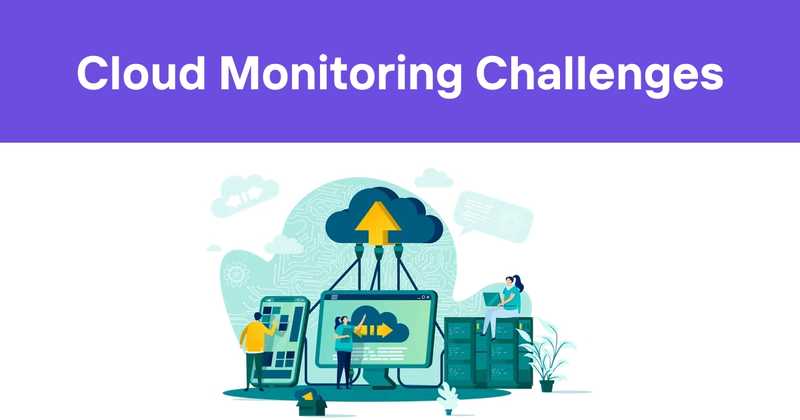Cloud Monitoring Challenges: How to Overcome Key Obstacles
Table of Contents
- Introduction
- Understanding Cloud Monitoring
- Common Cloud Monitoring Challenges
- Best Practices for Overcoming Cloud Monitoring Challenges
- The Future of Cloud Monitoring
- Conclusion
Introduction
Cloud computing has revolutionized the way organizations deploy and manage their IT infrastructure. With its scalability, flexibility, and cost-effectiveness, cloud technology has become an integral part of modern business operations. However, as cloud environments grow increasingly complex, monitoring these systems effectively has become a significant challenge for IT teams.
Cloud monitoring is critical for ensuring the performance, availability, and security of cloud-based applications and services. It provides visibility into resource utilization, helps identify and resolve issues quickly, and enables organizations to optimize their cloud investments. Yet, many businesses struggle with implementing effective cloud monitoring strategies due to various obstacles.
This article delves into the key challenges of cloud monitoring and provides practical solutions to overcome them. Whether you're a software developer, DevOps engineer, or IT manager, understanding these challenges and how to address them is crucial for maintaining a robust and efficient cloud infrastructure.
Understanding Cloud Monitoring
Before we dive into the challenges, let's briefly define cloud monitoring and its importance. Cloud monitoring involves tracking, analyzing, and managing cloud-based systems, applications, and infrastructure. It encompasses various aspects, including:
- Performance monitoring
- Resource utilization tracking
- Application and service availability
- Security and compliance monitoring
- Cost management
Effective cloud monitoring enables organizations to:
- Ensure optimal performance and user experience
- Detect and resolve issues proactively
- Maintain security and compliance
- Optimize resource allocation and costs
- Make data-driven decisions for capacity planning and scaling
Now that we have a basic understanding of cloud monitoring, let's explore the common challenges that organizations face in this area.
Common Cloud Monitoring Challenges
1. Scalability and Performance
Challenge: As cloud environments grow and become more complex, traditional monitoring tools often struggle to keep up with the increasing volume of data and the dynamic nature of cloud resources.
Impact: This can lead to performance bottlenecks, delayed alerts, and incomplete visibility into the cloud infrastructure.
2. Visibility Across Complex Environments
Challenge: Many organizations use multi-cloud or hybrid cloud architectures, combining services from different providers or integrating on-premises systems with cloud resources.
Impact: This complexity makes it difficult to achieve a unified view of the entire infrastructure, leading to blind spots and inconsistent monitoring practices.
3. Data Management and Analysis
Challenge: Cloud environments generate vast amounts of monitoring data, including logs, metrics, and traces from various sources.
Impact: Processing, storing, and analyzing this data efficiently can be overwhelming, making it challenging to extract meaningful insights and respond to issues promptly.
4. Security and Compliance
Challenge: Cloud environments introduce new security risks and compliance requirements that need to be continuously monitored and addressed.
Impact: Inadequate security monitoring can leave organizations vulnerable to data breaches, while failing to meet compliance standards can result in penalties and reputational damage.
5. Cost Management
Challenge: While cloud services offer flexibility, they can also lead to unexpected costs if not monitored and managed properly.
Impact: Without effective cost monitoring, organizations may overspend on cloud resources or struggle to allocate costs accurately across different departments or projects.
6. Tool Selection and Integration
Challenge: The market is flooded with various cloud monitoring tools, each with its own strengths and limitations.
Impact: Choosing the right tools and integrating them effectively with existing systems can be time-consuming and complex, potentially leading to tool sprawl or gaps in monitoring coverage.
Best Practices for Overcoming Cloud Monitoring Challenges
Now that we've identified the key challenges, let's explore best practices and strategies to overcome them:
Implement Automated, Scalable Monitoring
To address the scalability and performance challenges, implement automated monitoring solutions that can scale with your cloud infrastructure. Consider the following approaches:
-
Use cloud-native monitoring services: Take advantage of monitoring tools provided by your cloud service provider, such as Amazon CloudWatch, Google Cloud Monitoring, or Azure Monitor. These services are designed to scale with your cloud resources and offer deep integration with the provider's ecosystem.
-
Implement auto-scaling for monitoring resources: Configure your monitoring infrastructure to automatically scale based on the volume of data and the number of resources being monitored. This ensures that your monitoring capabilities can keep pace with your growing cloud environment.
-
Leverage distributed monitoring architectures: Implement a distributed monitoring architecture that can handle large volumes of data and provide real-time insights. This may involve using message queues, stream processing, or edge computing techniques to process monitoring data efficiently.
Example of auto-scaling configuration for monitoring resources:
kind: HorizontalPodAutoscaler
metadata:
name: monitoring-autoscaler
spec:
scaleTargetRef:
apiVersion: apps/v1
kind: Deployment
name: monitoring-service
minReplicas: 2
maxReplicas: 10
metrics:
- type: Resource
resource:
name: cpu
targetAverageUtilization: 50
Establish a Unified Monitoring Strategy
To improve visibility across complex environments:
-
Implement a centralized monitoring platform: Use a platform that can aggregate data from multiple cloud providers, on-premises systems, and third-party services. Tools like Prometheus, Grafana, or ELK stack (Elasticsearch, Logstash, and Kibana) can help create a unified view of your entire infrastructure.
-
Standardize monitoring practices: Develop and enforce consistent monitoring policies, naming conventions, and tagging strategies across all environments. This standardization makes it easier to correlate data and troubleshoot issues across different systems.
-
Use service maps and dependency tracking: Implement tools that can automatically discover and map the relationships between different services and components in your cloud environment. This helps in understanding the impact of issues and identifying root causes more quickly.
Example of a standardized tagging strategy:
| Tag Key | Description | Example Values |
|---|---|---|
| Environment | Deployment environment | production, staging, development |
| Service | Service or application name | web-app, database, cache |
| Team | Responsible team | devops, backend, frontend |
| Cost-Center | Financial allocation | marketing, engineering, sales |
Focus on Key Metrics and KPIs
To manage the overwhelming amount of data generated by cloud environments:
-
Define critical metrics and KPIs: Identify the most important metrics for your business and focus on monitoring these key performance indicators. This might include application response times, error rates, resource utilization, and business-specific metrics.
-
Implement intelligent alerting: Use anomaly detection and machine learning algorithms to create smart alerting mechanisms that reduce noise and highlight truly important issues.
-
Create custom dashboards: Design dashboards that provide at-a-glance views of your most critical metrics, allowing teams to quickly assess the health of their systems.
Example of key metrics to monitor for a web application:
| Metric | Description | Threshold |
|---|---|---|
| Response Time | Average time to process requests | < 200ms |
| Error Rate | Percentage of requests resulting in errors | < 1% |
| CPU Utilization | Average CPU usage across instances | < 70% |
| Memory Usage | Average memory consumption | < 80% |
| Active Users | Number of concurrent users | N/A (trend) |
Leverage AI and Machine Learning
Artificial Intelligence (AI) and Machine Learning (ML) can significantly enhance cloud monitoring capabilities:
-
Predictive analytics: Use ML models to predict potential issues before they occur, allowing for proactive problem resolution.
-
Anomaly detection: Implement AI-powered anomaly detection to identify unusual patterns in your monitoring data that might indicate performance issues or security threats.
-
Automated root cause analysis: Leverage AI to correlate events and metrics across your infrastructure to quickly pinpoint the root cause of problems.
-
Capacity planning: Use ML algorithms to forecast resource needs based on historical data and trends, enabling more accurate capacity planning.
Example of how AI can be used in cloud monitoring:
import numpy as np
# Assume 'data' is your monitoring metrics
data = np.array([[cpu_usage, memory_usage, network_traffic]
for cpu_usage, memory_usage, network_traffic in zip(cpu_data, memory_data, network_data)])
# Train the Isolation Forest model
model = IsolationForest(contamination=0.1, random_state=42)
model.fit(data)
# Predict anomalies
anomalies = model.predict(data)
# Anomalies are represented by -1, normal data by 1
anomaly_indices = np.where(anomalies == -1)[0]
print(f"Detected {len(anomaly_indices)} anomalies at indices: {anomaly_indices}")
Prioritize Security and Compliance
To address security and compliance challenges in cloud monitoring:
-
Implement comprehensive log management: Collect, centralize, and analyze logs from all cloud resources, applications, and security tools. This provides a comprehensive audit trail and helps in detecting security incidents.
-
Use cloud-native security services: Leverage security monitoring tools provided by cloud platforms, such as AWS GuardDuty, Azure Security Center, or Google Cloud Security Command Center.
-
Implement continuous compliance monitoring: Use tools that can continuously check your cloud configuration against compliance standards (e.g., CIS benchmarks, HIPAA, PCI-DSS) and alert on any deviations.
-
Encrypt sensitive monitoring data: Ensure that all monitoring data, especially those containing sensitive information, are encrypted both in transit and at rest.
Example of a compliance check using AWS Config:
"Source": {
"Owner": "AWS",
"SourceIdentifier": "EC2_INSTANCE_NO_PUBLIC_IP"
},
"Scope": {
"ComplianceResourceTypes": [
"AWS::EC2::Instance"
]
},
"InputParameters": {},
"ConfigRuleName": "ec2-instance-no-public-ip",
"ConfigRuleState": "ACTIVE",
"Description": "Checks whether Amazon Elastic Compute Cloud (Amazon EC2) instances have a public IP association. The rule is NON_COMPLIANT if the publicIp field is present in the Amazon EC2 instance configuration item."
}
Optimize Costs Through Effective Resource Management
To address cost management challenges:
-
Implement cost allocation tags: Use tagging strategies to accurately allocate costs to different projects, teams, or departments.
-
Set up budget alerts: Configure alerts to notify you when cloud spending approaches or exceeds predefined thresholds.
-
Use cost optimization tools: Leverage tools that can identify underutilized resources, recommend right-sizing, and suggest cost-saving measures.
-
Implement automated scaling policies: Use auto-scaling to automatically adjust resource capacity based on demand, helping to optimize costs during periods of low usage.
Example of a cost optimization report:
| Resource Type | Current Cost | Optimization Recommendation | Potential Savings |
|---|---|---|---|
| EC2 Instances | $1,000/month | Right-size 5 underutilized instances | $200/month |
| RDS Databases | $500/month | Convert 2 instances to Aurora Serverless | $100/month |
| S3 Storage | $200/month | Move 500GB to Glacier after 30 days | $50/month |
Choose the Right Tools and Integrate Effectively
To address the challenge of tool selection and integration:
-
Conduct a thorough assessment: Evaluate your monitoring needs, considering factors such as the complexity of your environment, budget, and team expertise.
-
Prioritize integration capabilities: Choose tools that offer robust APIs and pre-built integrations with your existing systems and cloud services.
-
Consider open-source options: Explore open-source monitoring tools like Prometheus, Grafana, or ELK stack, which offer flexibility and strong community support.
-
Implement a monitoring-as-code approach: Use infrastructure-as-code techniques to define and manage your monitoring configurations, ensuring consistency and enabling version control.
Example of a Terraform configuration for setting up monitoring resources:
name = "/app/production"
retention_in_days = 30
}
resource "aws_cloudwatch_metric_alarm" "high_cpu" {
alarm_name = "high-cpu-utilization"
comparison_operator = "GreaterThanThreshold"
evaluation_periods = "2"
metric_name = "CPUUtilization"
namespace = "AWS/EC2"
period = "300"
statistic = "Average"
threshold = "80"
alarm_description = "This metric monitors ec2 cpu utilization"
alarm_actions = [aws_sns_topic.alerts.arn]
dimensions = {
InstanceId = aws_instance.app_server.id
}
}
The Future of Cloud Monitoring
As cloud technologies continue to evolve, so too will the challenges and solutions in cloud monitoring. Here are some trends to watch:
-
AIOps and cognitive operations: The integration of AI and ML in IT operations will become more sophisticated, enabling predictive analytics, automated remediation, and more intelligent alerting systems.
-
Observability platforms: The focus will shift from traditional monitoring to observability, providing deeper insights into complex, distributed systems through logs, metrics, and traces.
-
Edge monitoring: With the growth of edge computing, monitoring solutions will need to adapt to manage and analyze data from edge devices and remote locations effectively.
-
Serverless monitoring: As serverless architectures become more prevalent, new monitoring approaches will emerge to handle the unique challenges of these environments, such as unpredictable scaling and short-lived compute instances.
-
Privacy-preserving monitoring: With increasing privacy regulations, monitoring solutions will need to incorporate privacy-preserving techniques to protect sensitive data while still providing valuable insights.
Conclusion
Cloud monitoring is a critical aspect of maintaining a robust and efficient cloud infrastructure. While it comes with its fair share of challenges, from scalability issues to cost management, these obstacles can be overcome with the right strategies and tools.
By implementing automated and scalable monitoring solutions, establishing a unified monitoring strategy, focusing on key metrics, leveraging AI and ML, prioritizing security and compliance, optimizing costs, and choosing the right tools, organizations can significantly improve their cloud monitoring capabilities.
As cloud technologies continue to evolve, it's crucial for IT teams to stay informed about the latest trends and best practices in cloud monitoring. By doing so, they can ensure that their monitoring strategies remain effective and continue to provide valuable insights that drive business success.
Remember, effective cloud monitoring is not just about collecting data – it's about turning that data into actionable insights that improve performance, enhance security, and optimize costs. By addressing these challenges head-on, organizations can unlock the full potential of their cloud investments and stay ahead in today's competitive digital landscape.



